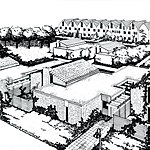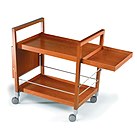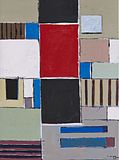Dieter winner
Dieter Josef Sieger (born May 3, 1938 in Münster ) is a German architect , shipbuilder , product designer , painter and art collector . He is one of the most prominent and renowned contemporary German designers. As a innovator of bathroom culture, Sieger wrote design history in the 1980s and 1990s, especially with his designs for the single-lever mixer “Domani” (1985) and the cross-handle mixer “Tara” (1992), both from Dornbracht.
Life
Dieter Sieger was born in Münster as the first of two children. He grew up in a frugal civil servant household who showed little understanding for the son's talent for drawing. As a schoolboy, Sieger attended an evening drawing course for adults at the Werkkunstschule in Münster . The encounter with the other course participants had a lasting impact on him and opened up new perspectives for him. In the following years Sieger made perspective drawings for the garden architect Rudolf Beaufays and got to know large houses of different industrialists through these assignments. During his repeated trips to Venice , Sieger drew views of the northern Italian landscape and the lagoon city and sold his work through the Frye Gallery in Münster.
After finishing school, Sieger completed a one-year internship with the architect Winfried Hoffmann and began a three-year training course as a bricklayer in Münster in 1957 . During this time he designed and looked after his first own building with a pilgrimage chapel in Wesuwe. In 1960 Sieger passed his journeyman's examination and, at the same time, graduated from the evening school . Two semesters followed at the engineering school in Münster before Sieger switched to the Werkkunstschule in Dortmund. Here he completed his architecture studies in 1964 with a state examination and opened an architecture office in Münster. While still a student, he designed his own house in Münster-Albachten and built parts of it with his own hands. At the end of 1964 he married the Dutch woman Fransje Blom, who worked in his office from the start and closely followed all projects and tasks.
Due to his own enthusiasm for sailing, Sieger's main focus shifted between 1976 and 1982 to equipping sailing and motor yachts. He designed more than 30 ships for various shipyards , including Anne Wever in s'Hertogenbosch and Heesen in Oss (Netherlands).
In the early 1980s, Sieger got into sanitary design and supplied designs and a. for the companies Alape, Dornbracht , Duravit and Hoesch. He was able to assert himself in competitions against designers such as Luigi Colani or Matteo Thun . He developed the complete bathroom into an independent market segment. He was also successful with industrial design and exhibition stand planning and worked as a consultant for various companies and in several committees.
From the mid-1980s, Sieger set up a second location in Venice, where he worked through the gallery owner Piero Mainardis de Campo u. a. met Alessandro Mendini , Fabrizio Plessi , Mimmo Paladino , Arnoldo Pomodoro, Miguel Berrocal , Alessio Sarri and Ettore Sottsass . Today Sieger is one of the largest Sottsass collectors in the world.
In 1988 Sieger moved his office to the von Ketteler Castle (part of the Harkotten double castle complex between Münster and Osnabrück ) and extensively renovated it. The garden of the baroque palace was designed by the Belgian garden architect Jacques Wirtz, the sculptures in the outdoor area are a.o. a. by Marte Röling, Andrea Branzi (drinking fountain), Miguel Berrocal , Alessandro Mendini , Ettore Sottsass ( pavilion ) and Fabrizio Plessi (sound installation).
From 1997 to 2000 Sieger was President of the German Designer Club and in 2001 took on a visiting professorship at the Zurich University of Design.
In 2003 the designer retired from the active management of his company and passed it on to his sons. Christian Sieger (* 1965), with the company since 1990, took over the commercial management of sieger design consulting GmbH in 1991 and established Sieger Design as one of the largest design offices in Germany . Designer Michael Sieger (* 1968), who introduced his first draft for Vorberg at the age of 19, is considered a perfectionist and visionary whose designs often anticipate international trends.
Dieter Sieger is still active today in design and realizes with his "masterpieces" design drafts in a consistently linear design language from the areas of furniture , lights and accessories . In addition, he turned to painting . He lives with his wife Fransje in the center of Münster.
In 2018, Sieger was awarded the Federal Cross of Merit on ribbon for his social commitment .
plant
Architecture │ interior design
Between 1964 and 1980 Sieger realized more than 500 houses, terraced houses and settlements , some of which he marketed himself. He achieved his breakthrough as an architect in 1970 with a row house development in Albachten, which won several awards. There were also major projects such as NATO apartments and industrial and administrative buildings, including the Duravit factory in Meißen and the Ritzenhoff headquarters in Marsberg . Beyond Germany, Sieger worked as an architect in Greece, Spain, France, Saudi Arabia and the USA.
Sieger's designs are characterized by practical floor plans , the use of state-of-the-art technology and a strong connection to nature. This is also reflected in the garden design that is often carried out with. His “garden courtyard houses”, which still exist today, show a special permeability in the depth of the building , which extends from the entrance to the garden courtyard. Sieger attached particular importance to turnkey construction at a time when this was still viewed very critically by the Association of German Architects ( BDA).
As early as the 1960s, Sieger designed the bathrooms for his houses himself and was one of the first to equip them with two sinks and specially made mirror cabinets.
In the 1990s, Sieger took on a large number of orders in the field of interior design , from the design of branch networks (including westlotto, Deutsche Bahn) to planning individual premium bars (including restaurants , theaters ).
Shipbuilding
At the end of the 1970s, Sieger found the interior design of sailboats and yachts . His particular merit here lies in what was then a revolutionary modern design that went beyond traditional wood furnishings. The presentation of a Trintella 42 designed by him from the Dutch shipyard Anne Wever at the Düsseldorf boat show in 1979 turned out to be trend-setting for the development of a modern, contemporary interior for ocean-going yachts.
Winner worked u. a. together with ship designers Ron Holland von Swan, Peter Belsnyder and German Frers . The 65-foot yacht Blue Ocean from the Heesen shipyard, designed by Sieger and equipped with an aluminum hull, was the largest ship ever exhibited at the “boot” in Düsseldorf in 1982 . It developed into a crowd puller mainly because of its interior design . Overall, Sieger designed around 30 yachts for customers around the world in around 10 years. Reports about him as a boat designer appeared in all well-known specialist magazines such as “Yachting Boat”, “Boats”, “Yacht” and “Exclusive Nautica”.
design
The work of the designer Dieter Sieger is shaped by his origins as an architect . Basic geometric shapes, a mostly strictly reduced formal language and an elegant handwriting characterize his designs. These reflect his extensive knowledge of the design history of the 20th century as well as the contemporary design scene. One of the special features of Sieger is that he also deals with the chances of realization with every design by conducting meticulous material studies and comprehensively studying the production conditions . Also, packaging and marketing are often the subject of his scale in terms of an overall design.
Plumbing design
In the early 1980s, Dieter Sieger entered an industry that was dominated by Italy in terms of design , but was not very innovative in Germany at the time. He saw the bathroom as part of the daily living area and coordinated the individual parts of the sanitary fittings with one another. Some of Sieger's designs quickly developed into design classics .
Sieger developed the first products in the sanitary area for the company Alape, which specializes in enamel basins. In 1983, the partly colored LavarSet washing area with accessories program was presented at the ISH international sanitary fair in Frankfurt in an exhibition stand also designed by Sieger. The equipment, consisting of a wash basin , shelf, mirror and lighting, still clearly echoes Sieger's design drafts in shipbuilding.
With the Dornbracht - fitting revolutionized "Domani" winning the mid-1980s, the bathroom design and cleared the way for new shapes and design ideas. The fitting has received numerous awards and made it onto the cover of MD - Interior Design Architecture in June 1985 . In 1986, the winner was awarded the Japanese State Design Prize for this design .
Sieger's “Tara”, an archetype of the fitting, designed as a cross-handle fitting, was repeatedly copied and often brought onto the market as plagiarism . The cross handles take shapes from the early days of the bathroom and implement them in a contemporary way. The Tara fitting is now a Dornbracht design icon and is installed in many leading hotels worldwide, from the W Hollywood (Los Angeles) and Grand Hyatt (Tokyo) to the Swissôtel Krasnye Holmy (Moscow) to the 6-star built by Norman Foster -Hotel Dolder (Zurich).
For Duravit Sieger u. a. the Giamo series based on circles and circle segments, which was presented in 1987 on a post-modern stand at the ISH. In the history of the sanitary industry, it represents the first complete bathroom furniture idea for which several manufacturers coordinated their respective products. In retrospect, Duravit describes the collaboration with Sieger as the beginning of its extremely successful design strategy.
Utility design
Dieter Sieger's utility design products include u. a.
- Bags and cases (Scala for Dey, 1989)
- Door handle (SO 8820 for Ogro, 1989)
- Tile series (Cinema for AWS, Picto for Agrob, both 1987)
- Lights (table and floor lamp Bird for GKS lights, 1989; series / wall lights Doppio and Becco for GKS lights, Bolero for Peill + Putzler, 1990; Puccini, Zazou, Piazza, Perdita, Ninas for Peill + Putzler, 1992)
- Mirror cabinets (for Twick and Lehrke)
- vase collections (for Ritzenhoff, 1992)
- Porcelain (including the Cult series based on architectural elements for Arzberg, 1993)
- Jewelry (including the wristwatch "Dieter Sieger No.1", which was awarded the Chronos Innovation Prize in 2002, and the "Bugatti Diamond Luxuries" diamond collection developed for Bugatti )
- Cutlery (Materia series for WMF, 1997)
- as well as technical devices ( water heater DHE for Stiebel Eltron, 1991; small storage tank KS for Stiebel Eltron , passepartout cigarette vending machine for Harting, 1992; rapid heater CK for Stiebel Eltron, 1993).
For the Programat 4 coffee machine , Dieter Sieger developed both design and technology in 1992. The self-explanatory device for the professional sector advanced to become a design icon and made Sieger Design internationally known.
The “Ritzenhoff” milk glass project initiated by Sieger Design achieved cult status in the 1990s. For the Marsberg- based Ritzenhoff glass works, the conception of a new brand and qualification of the sales channel meant a quantum leap . Michael Sieger designed the first glass with black spots on a transparent background, the design of which as a cow skin only becomes fully visible through the filled milk . For the simple, conical milk glass, more than 250 world-famous designers have contributed their décor designs, including Ettore Sottsass , Alessandro Mendini , Aldo Cibic, Michael Graves , Coop Himmelb (l) au and Shigeru Uchida. In 2005 Sieger Design withdrew from the management of the mass product , and in 2017 the collaboration was resumed.
Masterpieces
The “Masterpieces” are a collection of design pieces from the areas of furniture , lighting and accessories that Dieter Sieger has been working on continuously since 2003. There are no clients for these designs , they arise solely from the personal needs or the personal ideas of the designer. In their architectural straightforwardness, reduced to geometric shapes, they reflect Dieter Sieger's distinctive formal language, their execution corresponds to his understanding of materials, which is geared towards the highest quality of craftsmanship.
painting
Since around 2003 Dieter Sieger has been devoting himself to painting with ever increasing intensity and is thus returning to his beginnings, when he earned his first money with drawings .
Sieger worked as an architect , shipbuilder and product designer at a time when drafts were still being put on paper by hand; It was not until the 1980s that the computer took on a multitude of tasks. Dieter Sieger, however, still prefers to draw himself today. The formal language recognizable in Sieger's paintings seems to have developed especially from the early landscape and architectural sketches, with which he follows the tradition of abstract painting by Lyubow Sergejewna Popowa , Piet Mondriaan , Paul Klee and Serge Poliakoff poses. Especially this Russian painter who by Kandinsky , Delaunay and Otto Freundlich to abstraction found can, as Mentor apply winner for its geometrically-inspired works. Not least because the second work that Sieger acquired as a young art collector was a large-format Poliakoff that has been before his eyes every day since 1968.
In contrast, echoes of Ernst Wilhelm Nay can be found in Sieger's colored paintings, which are completely detached from the linearly limited form. Contrary to the straightforwardness of his designs, Sieger found an emotional expression in his painting that reflected his great understanding of color and form , but at the same time celebrated inaccuracy. The color fields appear spontaneously put together, which do not have to follow any function here . The line, the most important element of the draftsman and designer, is increasingly disappearing from the painterly works, which can be understood as the opposite pole to Sieger's design products.
Prices (selection)
2009: “Aqua Cultura” award for services to the German sanitary industry
2002: “DDC” award for the overall Blome appearance
1989: Dutch State Prize for the Domani fitting (Dornbracht), Goed Industrieel Ontwerp
1988: Japanese State Prize for the Point fitting (Dornbracht), Good Prize for Foreign Product
1987: State Prize for Design and Innovation of the State of North Rhine-Westphalia for the Domani fitting (Dornbracht) and the LavarLo washstand and mirror
1986: Japanese State Prize for the Domani fitting (Dornbracht)
iF product design award: Award for good design, Industrie Forum Design Hannover │ 2001: TG 9830 door handle for Orgo, 1997: Milch + Kakao for Arzberg, 1995: Tara fitting for Dornbracht, Tara Classic fitting for Dornbracht, 1994: milk glass collection for Ritzenhoff, 1993: Glass collection for Ritzenhoff, Programat 4 coffee machine for WMF, 1991: Electric heat storage ETW Ethermat for Stiebel Eltron
iF product design award: Award for ecology and design, Industrie Forum Design Hannover │ 1995: Dinner service Cult for Arzberg
iF communication design award │ 1999: Exhibition stand for Mubea
“Die gute Industrieform” rating, Hanover │ 1992: Dal Adagio, cistern for DAL, 1991: DHE instantaneous water heater for Stiebel Eltron, 1986: LavarLo washbasin and mirror for Alape, Domani shower bath for culvert
Red Dot Best of the Best, Design Center NRW │ 2002: eMote infrared faucet from Dornbracht
red dot award: Award for high design quality, Design Center North Rhine-Westphalia │ 2000: Chef's knife Materia for WMF, 1998: Get Fresh system solution for Kuhfuss, Cult table service for Arzberg, 1995: Cult table service for Arzberg, 1994: Tara fitting for Dornbracht, 1993 : Frosted glass collection for Ritzenhoff, 1987: Giamo washbasin and bathroom furniture for Duravit
DDC Design Award │ 2000: Bronze for the “Fresh Up” sanitary system for Kuhfuß, 1999: Bronze for the “Materia” cutlery for WMF
Good Design Award Chicago │ 1999: Decorative elements for the bathroom for Octopus, Tara fittings for Dornbracht, 1998: Materia cutlery for WMF, 1996: Beer glass collection for Ritzenhoff
Certificate of Design Excellence, European Regional Design Annual │ 1997: Beer glass packaging for Ritzenhoff
Design Plus rating, Frankfurt International Fair │ 1995: Cult dinner service for Arzberg
NGZ Service Management Award, Hotel Design │ 1991: Garden Hotel No. 7, Hamburg
Award for innovative product design, IHK Südwestfalen │ 1985: Armatur Domani, Dornbracht
Exhibitions │ collections
1994/95: Münster City Museum “Dieter Sieger. Architect, shipbuilder, designer "
Since 1989: Represented with 4 designs in the Design Museum London
Since 1984: Represented in the Design Center Stuttgart with 13 designs today
Since 1985: Represented in the New Collection of the Museum of Applied Arts, Munich
Since 1991: Represented in the permanent product show of the Design Center North Rhine-Westphalia
Literature (selection)
Thomsen, Christian W., Dieter Sieger: Architect - Shipbuilder - Designer, Tübingen 1994
Thomsen, Christian W., Dieter Sieger: Architect - Shipbuilder - Designer, Tübingen 1994
Sieger Design Consulting, SIEGER DESIGN 1983-1994, Sassenberg 1994
Il Bagno, March 1995, pp. 76-85
Thomsen, Christian W., Sieger Design: Strategies of Success, Tübingen 2002
Sieger, Dieter and Fransje, memories, private edition 2005
Cieslack, Matthias, Dieter Sieger Masterpieces, Sassenberg 2005
Exhibition catalog Stadtmuseum Münster, Dieter Sieger. Architect, shipbuilder, designer, Münster 1994
Entries in: Designlexikon International, The Museum of Modern Art Design Encyclopedia
Documentation by WDR, 45 min., Broadcast January 27, 1991
Web links
- http://www.sieger-design.com/
- http://www.dietersieger.com/
- http://conmoto.com/
- http://www.baddesign.de/sieger.php
- http://www.designlexikon.net/Designer/S/siegerdieter.html
- http://www.domfreunde.de/design/
- http://www.alape.com/de-de/unternehmen/uber_alape/design/79.html
- http://www.schoener-wohnen.de/designer-lexikon/17639-dlxk-sieger-design#37676
Individual evidence
| personal data | |
|---|---|
| SURNAME | Winner, Dieter |
| ALTERNATIVE NAMES | Winner, Dieter Josef (full name) |
| BRIEF DESCRIPTION | German architect, shipbuilder, product designer, painter and art collector |
| DATE OF BIRTH | May 3, 1938 |
| PLACE OF BIRTH | Muenster |














